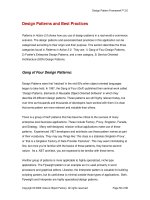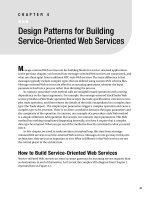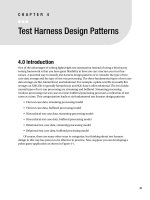5-Structural Design Patterns.ppt
Bạn đang xem bản rút gọn của tài liệu. Xem và tải ngay bản đầy đủ của tài liệu tại đây (624.83 KB, 47 trang )
Design Pattern
1
Structural design
patterns
Design Pattern 2
Structural design patterns
Adapter
Bridge
Composite
Decorator
Façade
Flyweight
Proxy
Design Pattern
3
The Adapter Pattern
Putting a Square Peg in a Round
Hole!
Design Pattern 4
What is Adapters
Real world is full of them!
Design Pattern 5
Object oriented adapters
Scenario: you have an existing software system
that you need to work a new vendor library into,
but the new vendor designed their interfaces
differently than the last vendor.
What to do? Write a class that adapts the new
vendor interface into the one you’re expecting.
Your Existing
System
Vendor
Class
Their interface doesn’t match
the one you’ve written your code
against. Not going to work!
Design Pattern 6
Object oriented adapters
Your Existing
System
Vendor
Class
Adapter
The adapter
implements the
interface your
classes expect
Your Existing
System
Vendor
Class
Adapter
No code
changes
New code
No code
changes
And talks to the
vendor interface to
service your requests
Design Pattern 7
The Adapter Pattern - Intent
The client sees only the
Target interface.
The Adapter implements the
target interface
All requests get
delegated to the
Adaptee
Adapter is composed
with the Adaptee
Full of good OO design principles:
- Use of object composition
- Pattern binds the client to an
interface and not an implementation
Full of good OO design principles:
- Use of object composition
- Pattern binds the client to an
interface and not an implementation
The Adapter Pattern converts the interface of a class into
another interface the clients expect. Adapter lets classes
work together that couldn’t otherwise because of
incompatible interfaces.
Object Adapter
Design Pattern 8
Object and Class Adapters
There are two types of Adapters
Object Adapter : use composition to adaptive the adaptee.
Class Adapter : use inheritance.
Class Adapter
Design Pattern 9
Applicability
Use the Adapter pattern when
want to use an existing class, and its interface does not
match the one you need.
want to create a reusable class that cooperates with
unrelated or unforeseen classes that don't necessarily have
compatible interfaces.
Class and object adapters have different trade-
offs.
A class adapter won't work when we want to adapt a class
and all its subclasses.
An object adapter lets a single Adapter work with the
Adaptee itself and all of its subclasses (if any).
Design Pattern 10
Example
Turkey has a incompatible
interface with Duck. We’d
like to use some Turkey
as Duck
Target interface Adaptee
Design Pattern 11
Write Adapter
implements the
interface of the
Target, and get a
reference to adaptee
Target interface Adaptee
Design Pattern 12
Using two-way adapters to provide transparency
Design Pattern 13
Example: Adapting an Enumeration to
an Iterator
Target interface Adaptee interface
We are making the Enumeration in your old code look like Iterator for
your new code.
Design Pattern 14
Example: Adapting an Enumeration to
an Iterator
EnumerationIterat
or is the Adapter
A class implementing the
Enumeration interface is
the adaptee.
Design Pattern 15
Summary
When you need to use an existing class and its interface is
not the one you need, use an adapter.
An adapter changes an interface into one a client expects.
Implementing an adapter may require little work or a
great deal of work depending on the size and complexity of
the target interface.
There are two forms of adapter patterns: object and class
adapters. Class adapters require multiple inheritance.
An adapter wraps an object to change its interface, a
decorator wraps an object to add new behaviors and
responsibilities.
Design Pattern
16
The Façade Pattern
Simplify, simplify, simplify!
Design Pattern 17
The Facade Pattern – Key Features
Problem
Need to use only a subset of a complex system.
Or you need to interact with the system in a particular way.
Façade Pattern Intent:
Provide a unified interface to a set of interfaces in a
subsystem.
Facade defines a higher-level interface that makes the
subsystem easier to use.
Design Pattern 18
The Facade Pattern – Key Features
Structure
Client
Facade
subsystem classes
Design Pattern 19
The Facade Pattern – Participants
Facade
knows which subsystem classes are responsible for a
request.
delegates client requests to appropriate subsystem objects.
Subsystem classes
implement subsystem functionality.
handle work assigned by the Facade object.
have no knowledge of the façade
Design Pattern 20
The Facade Pattern – Applicability
Use the Facade pattern when
want to provide a simple interface to a complex
subsystem.
decouple the subsystem from the dependencies of
clients and other subsystems, thereby promoting
subsystem independence and portability.
want to layer your subsystems. Use a facade to
define an entry point to each subsystem level.
Design Pattern 21
Example - Home Sweet Home Theater
That’s a lot of
classes, a lot of
interactions, and
a big set of
interfaces to
learn and use.
Design Pattern 22
Watching a Movie the Hard Way!
1. Turn on the popcorn popper
2. Start the popper popping
3. Dim the lights
4. Put the screen down
5. Turn the projector on
6. Set the projector input to DVD
7. Put the projector on wide-screen mode
8. Turn the sound amplifier on
9. Set the amplifier to DVD input
10. Set the amplifier to surround sound
11. Set the amplifier volume to medium (5)
12. Turn the DVD player on
13. Start the DVD player playing.
14. Whew!
But there’s more!
When the movie is done,
- how do you turn
everything off?
- Do you reverse all the
steps?
Façade to the Rescue!!
Example explain
Create a Façade for the HomeTheater which exposes a
few simple methods such as watchMovie()
The Façade treats the home theater components as its
subsystem, and calls on the subsystem to implement its
watchMovie() method.
The Client now calls methods on the façade and not on
the subsystem.
The Façade still leaves the subsystem accessible to be
used directly.
HomeTheaterFacade manages all those subsystem
components for the client. It keeps the client simple and
flexible.
Design Pattern 25
Summary
When you need to simplify and unify a large interface or a
complex set of interfaces, use a façade.
A façade decouples the client from a complex subsystem.
Implementing a façade requires that we compose the
façade with its subsystem and use delegation to perform
the work of the façade.
You can implement more than one façade for a subsystem.
A façade "wraps" a set of objects to simplify!









